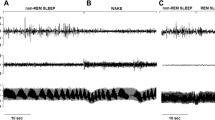Abstract
Respiratory muscle activity assists many bodily functions for purposes other than mere tissue oxygenation. Respiratory musculature, for example, are used in vocalization, for providing thoracic and abdominal pressure for defecation and urination, and for maintaining thoracic pressure and body position in somatic movements. Respiratory musculature are used heavily in some species for temperature regulation; tachypnea and upper airway dilation, for example, are primary mechanisms used for cooling in selected animals. Use of the respiratory musculature for these actions involves precise coordination of a number of brain structures, and those brain structures incorporate a number of rostral brain regions in addition to the classical brain stem “dorsal” (e.g., nucleus of solitary tract) and “ventral” (e.g., nucleus ambiguus) respiratory groups typically outlined in the respiratory control literature.
Access this chapter
Tax calculation will be finalised at checkout
Purchases are for personal use only
Preview
Unable to display preview. Download preview PDF.
Similar content being viewed by others
References
Abeles, M., Quantification, smoothing, and confidence limits for single-units’ histograms, J. Neurosci. Methods, 5 (1982) 317–325.
Bandler, R., Brain mechanisms of aggression as revealed by electrical and chemical stimulation: suggestion of a central role for the midbrain periaqueductal grey region, In: Progress in Psychiobiology and Physiological Psychology (Vol. 13), Epstein A. and Morrison A. (Eds.), Academic Press, New York, 1988, pp. 67–154.
Bandler, R., Carrive, P., and Zhang, S.P., Integration of somatic and autonomic reactions within the midbrain periaqueductal grey: Viscerotopic, somatotopic and functional organization, Prog. Brain Res., 57 (1991) 269–305.
Bandler, R. and Tork, I., Midbrain periaqueductal grey region in the cat has afferent and efferent connections with solitary tract nuclei, Neurosci. Lett., 74 (1987) 1–6.
Frysinger, R.C. and Harper, R.M., Cardiac and respiratory relationships with neural discharge in the anterior cingulate cortex during sleep-waking states, Exp. Neurol., 94 (1986) 247–263.
Frysinger, R.C. and Harper, R.M., Cardiac and respiratory correlations with unit discharge in epileptic human temporal lobe, Epilepsia, 31 (1990) 162–171.
Frysinger, R.C., Zhang, J. and Harper, R.M., Cardiovascular and respiratory relationships with neuronal discharge in the central nucleus of the amygdala during sleep-waking states, Sleep, 11 (1988) 317–332.
Griffith, N., Engel, J. and Bandler, R., Ictal and enduring interictal disturbances in emotional behaviour in an animal model of temporal lobe epilepsy, Brain Res., 400 (1987) 360–364.
Harper, R.M., Frysinger, R.C., Trelease, R.B. and Marks, J.D., State-dependent alteration of respiratory cycle timing by stimulation of the central nucleus of the amygdala, Brain Res., 306 (1984) 1–8.
Harper, R.M. and McGinty, D.J., A technique for recording single neurons from unrestrained animals, In: Brain unit activity during behavior, Phillips M.I. (Ed.), Charles C. Thomas, Springfield, Illinois, 1973, pp. 80–104.
Harper, R.M., Sclabassi, R.J. and Estrin, T., Time series analysis and sleep research, IEEE Trans. Automatic Control, 19 (1974) 932–943.
Holstege, G., Anatomical study on the final common pathway for vocalization in the cat, J. Comp. Neurol., 284 (1989) 242–252.
Hiyoshi, T., Matsuda, M., and Wada, J.A., Centrally induced feline behavior and limbic kindling, Epilepsia, 31 (1990) 359–369.
Jouvet, M., Paradoxical sleep — a study of its nature and mechanisms, Prog. Brain Res., 18 (1965) 20–62.
Larson, C.R. and Kistler, M.K., The relationship of periaqueductal gray neurons to vocalization and the laryngeal EMG in the behaving monkey, Exp. Brain Res., 63 (1986) 596–606.
Mancia, G. and Zanchetti, A., Cardiovascular regulation during sleep, In: Physiology in sleep, Orem J. and Barnes C.D. (Eds.), Academic Press, New York, 1980, pp. 2–55.
Morrison, A.R., Paradoxical sleep without atonia, Arch. Ital. Biol., 126 (1988) 275–289.
Ni, H., Zhang, J.X. and Harper, R.M., Respiratory-related discharge of periaqueductal gray neurons during sleep-waking states, Brain Res., 511 (1990) 319–325.
Ni, H., Zhang, J.X. and Harper, R.M., Cardiovascular-related discharge of periaqueductal gray neurons during sleep-waking states, Brain Res., 532 (1991) 242–248.
Orem, J., Netick, A. and Dement, W.C., Breathing during sleep and wakefulness in the cat, Respir. Physiol., 30 (1977) 265–289.
Perkel, D.H., Gerstein, G.L. and Moore, G.P., Neuronal spike trains and stochastic point processes. II. Simultaneous spike trains, Biophys. J., 7 (1967) 419–440.
Sauerland, E.K. and Harper, R.M., The human tongue during sleep: electromyographic activity of the genioglossus muscle, Exp. Neurol., 51 (1976) 160–170.
Schenk, C.H., Bundle, S.R., Patterson, A.L. and Mahowald, M.W., Rapid eye movement sleep behavior disorder. A treatable parasomnia affecting older adults, JAMA, 257 (1987) 1786–1789.
Sieck, G.C and Harper, R.M., Pneumotaxic area neuronal discharge during sleep-waking states in the cat, Exp. Neurol., 67 (1980) 79–102.
Snider, R.S. and Niemer, W.T., A Stereotaxic atlas of the cat brain, University of Chicago Press, Chicago, 1970.
Sterman, M.B. and Clemente, C.D., Forebrain mechanisms for the onset of sleep, In: Basic sleep mechanisms, Petre-Quadens O. and Schlag J.D. (Eds.), Academic Press, New York, 1974, pp. 83–97.
Zhang, J.X. and Harper, R.M., A new microdrive for extracellular recording of single neurons using fine wires, Electroencephalogr. Clin. Neurophysiol., 57 (1984) 392–394.
Zhang, J.X., Harper, R.M. and Frysinger, R.C., Respiratory modulation of neuronal discharge in the central nucleus of the amygdala during sleep and waking states, Exp. Neurol., 91 (1986a) 193–207.
Zhang, J.X., Harper, R.M. and Ni, H., Cryogenic blockade of the central nucleus of the amygdala attenuates aversively conditioned blood pressure and respiratory responses, Brain Res., 386 (1986b) 136–145.
Author information
Authors and Affiliations
Editor information
Editors and Affiliations
Rights and permissions
Copyright information
© 1991 Springer Science+Business Media New York
About this chapter
Cite this chapter
Harper, R.M., Ni, H., Zhang, J. (1991). Discharge Relationships of Periaqueductal Gray Neurons to Cardiac and Respiratory Patterning During Sleep and Waking States. In: Depaulis, A., Bandler, R. (eds) The Midbrain Periaqueductal Gray Matter. NATO ASI Series, vol 213. Springer, Boston, MA. https://doi.org/10.1007/978-1-4615-3302-3_4
Download citation
DOI: https://doi.org/10.1007/978-1-4615-3302-3_4
Publisher Name: Springer, Boston, MA
Print ISBN: 978-1-4613-6453-5
Online ISBN: 978-1-4615-3302-3
eBook Packages: Springer Book Archive




